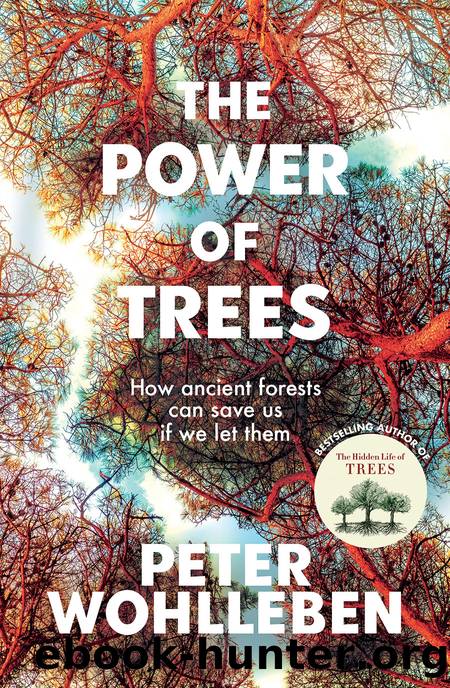The Power of Trees by Peter Wohlleben

Author:Peter Wohlleben
Language: eng
Format: epub
Publisher: Schwartz Books Pty. Ltd.
18
Itâs Time to Pay Up
A WHIFF OF FLOWER POWER always accompanies methods that tread gently on the landâthe suggestions sound attractive but are not taken seriously. I get that all the time when it comes to using horsepower in the forest. In contrast to heavy machines, heavy horses that pull trees out of the forest cause minimal damage to the forest floor. And using horses is not that much more expensive, especially if you factor in the damage the steel monsters inflict on the soil. And yet working with animals is considered a romantic throwback to forests past, whereas harvest machinery steered by joystick and computer is like using a smartphone in the forestâa model of modernity and efficiency.
Thereâs a similar trend when it comes to sequestering carbon: out with nature and in with technology. Itâs called (an acronym, of course) CCS, which stands for carbon capture and storage. Greenhouse gases are captured and stored at vast effort and expense to keep them out of the atmosphere. According to an article in the Frankfurter Allgemeine Zeitung published in January 2021, Elon Musk advertised that he would reward whoever invented the best technological fix with a million-dollar prize.1 If trees could, they would now shyly raise their handsâor rather, their branchesâand say: âWeâve already invented this, although it was more than 300 million years ago. Does that count?â
TO COMPARE THE SERVICES trees offer with what modern technology can do, letâs first take a look at the technology. It hasnât got much further than the experimental stage and it sounds slightly mad. First, carbon dioxide is released to create energy, and then this energy is used to recapture carbon dioxide so it can be disposed of. The process is expensive and, in the final analysis, increases fossil fuel use by up to 40 percent. And then the next problem looms. What to do with the captured carbon?
Most solutions envision underground storage systems, perhaps in deep layers of rock. Scientists estimate, however, that only 65 to 80 percent of the greenhouse gas will stay there; the rest will escape back up to the surface. On its way up, the gas can bring salty groundwater along with it, which damages soil.2 Apart from that, deep rock layers and groundwater are unique, sensitive ecosystems. If we gas them with carbon dioxide, we have no idea what the consequences will be for the communities that live there. And then there are the enormous costs: projects like Norwayâs Project Longship, where in a couple of years carbon dioxide will be transported by pipeline to be stored 2.5 miles (4 kilometers) below the ocean floor, are estimated to cost 100 euros a metric ton, the unit universally used to measure carbon storage and the one I will use for carbon calculations.3
Trees offer carbon storage with absolutely no risk to the environment, and they throw in all the other services forests provide for free. On average, beeches, oaks, and other species store the equivalent of 10 metric tons of carbon dioxide per hectare per year.
Download
This site does not store any files on its server. We only index and link to content provided by other sites. Please contact the content providers to delete copyright contents if any and email us, we'll remove relevant links or contents immediately.
| Cacti & Succulents | Flowers |
| Mushrooms | Trees |
Sapiens: A Brief History of Humankind by Yuval Noah Harari(13065)
The Tidewater Tales by John Barth(12034)
Do No Harm Stories of Life, Death and Brain Surgery by Henry Marsh(6340)
Mastermind: How to Think Like Sherlock Holmes by Maria Konnikova(6243)
The Thirst by Nesbo Jo(5790)
Why We Sleep: Unlocking the Power of Sleep and Dreams by Matthew Walker(5649)
Sapiens by Yuval Noah Harari(4544)
Life 3.0: Being Human in the Age of Artificial Intelligence by Tegmark Max(4514)
The Longevity Diet by Valter Longo(4449)
The Rules Do Not Apply by Ariel Levy(3909)
The Immortal Life of Henrietta Lacks by Rebecca Skloot(3829)
The Body: A Guide for Occupants by Bill Bryson(3807)
Why We Sleep by Matthew Walker(3778)
Animal Frequency by Melissa Alvarez(3756)
Yoga Anatomy by Kaminoff Leslie(3706)
Barron's AP Biology by Goldberg M.S. Deborah T(3634)
The Hacking of the American Mind by Robert H. Lustig(3584)
All Creatures Great and Small by James Herriot(3521)
Yoga Anatomy by Leslie Kaminoff & Amy Matthews(3398)
